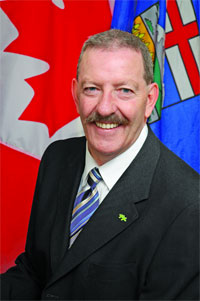
Features
Leadership
Leadership Forum: The art of shifting gears – a team effort
This edition of Leadership Forum was created in collaboration with Dr.
John Moffatt, who is a partner with Blackstock Moffatt Associates in
Sherwood Park, Alta. Blackstock Moffatt Associates is a non-profit
provider of leadership training and development services.
December 6, 2007
By E. David Hodgins
 This edition of Leadership Forum was created in collaboration with Dr.
This edition of Leadership Forum was created in collaboration with Dr.
John Moffatt, who is a partner with Blackstock Moffatt Associates in
Sherwood Park, Alta. Blackstock Moffatt Associates is a non-profit
provider of leadership training and development services. Moffat holds
a B.Ed., M.Ed. and PhD in education and psychology and works with
progressive leaders in public safety, business, government, industry
and the helping professions engaged in the pursuit of quality
management, motivation and productivity. He is an award-winning
international speaker. It was a real pleasure to team up with him to
write this piece.
Shifting gears together was something my teen
friends and I did for fun many years ago. The majority of vehicle
transmissions were manual and, while traveling down the dusty gravel
back roads of rural Quebec, two of us would sometimes co-pilot the
pick-up truck. The driver would push in the clutch and the passenger,
usually the younger and unlicensed co-pilot, would change gears.
Looking back, this was a dangerous practice but remember, this was BS –
before seatbelts.
The purpose of using the "shifting gears
together" descriptor is to emphasize the critical importance of working
together, especially during times of change in culture-centered
organizations. Progress is not possible if the driver fails to push in
the clutch or the co-pilot fails to move the shift lever – they have to
work in sync. Vincent van Gogh wisely noted, "Great things are not done
by impulse, but by a series of small things brought together."
Successful leadership is closely connected to one's ability to get the
job done through the efforts of others.
Collaborative work
environments are essential to achieve success. The real challenge is
being able to create, evolve and maintain functioning and effective
work teams while addressing issues resultant from change.
An
effective team is defined as: "A group of people who achieve the goals
necessary despite common organizational obstacles and the members enjoy
the process of working together." When a public safety organization is
in the development or growth mode, the first order of business is to
"scan the internal environment That means assessing how employees feel
about their work team and their situation during the transition. Under
the umbrella of a "new team start up" there is a need to take the pulse
of the organization.
One way to do this is to administer a
team-health questionnaire. The goal of the questionnaire is to obtain
the facts about key issues and areas relative to group success in
problem solving, decision making, action planning and action taking.
Research, expert opinion and the 20/20 hindsight of experienced
professionals are part of the next phase. These experts probe staff
perceptions regarding the organization's leadership, membership, group
commitment, work climate, achievement orientation, corporate role, work
methods, organization, feedback style, individual development and the
state of inter-group relations. The results provide an opportunity to
accurately rank each of the team's health themes from the greatest
strengths to the greatest "developmental opportunities." To complement
and supplement the questionnaire, voluntary and confidential one-on-one
interviews are conducted with each staff member. The aim here is to
gain clarity about the organization's internal strengths and weaknesses
as well as the external opportunities and threats. The proverbial SWOT
(strengths, weaknesses, opportunities, threats) analysis works well
here. Interview responses and findings consistent with the
questionnaire results provide helpful suggestions for bettering the
organization.
The next steps involve correlating, interpreting
and presenting the data to the organization's decision makers. This
phase includes presenting specific recommendations to the senior
leaders for their consideration and subsequent action. According to the
model the findings must be published and distributed to all staff
members with follow-up meetings to address particular areas of interest
for each work team.
To ensure a healthy and productive
organization, professional assistance is necessary to identify issues
and address the challenges and opportunities uncovered by work teams.
Teams and individuals must be in full partnership in making decisions
that affect workers' lives. Remember, we're in this together. There are
lots of smarts and wisdom at every level in every organization. It's
the leader's responsibility to effectively mine these talents for the
benefit of all. And, given the incredible passion found in pubic-safety
organizations, that is especially true of those organizations.
Dr. Moffatt may be contacted at blkmoff@shaw.ca .
David Hodgins is the managing director,
Alberta Emergency Management Agency. He is a former assistant deputy
minister and fire commissioner for British Columbia. A 30-year veteran
of the fire service, he is a graduate of the University of Alberta’s
public administration program and a certified emergency and disaster
manager. E-mail: David.Hodgins@gov.ab.ca
Print this page
Advertisement
- Comment: Knowledge equals effectiveness
- NFPA Impact: Fire service must respond to lack of statistics